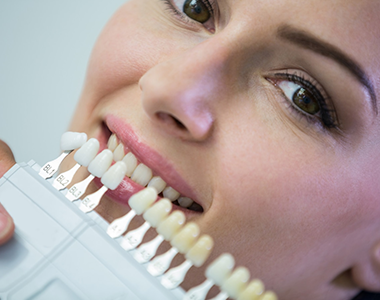
Cosmetic dentistry
Category : Gentalcare
If you’re not satisfied with your smile, modern cosmetic dentistry can help. This method of professional oral care focuses on improving the appearance of your mouth, teeth, gums, and overall smile. Common procedures include teeth whitening, veneers, fillings, and implants.
Cosmetic dentistry is becoming more and more popular, with the industry as a whole projected to reach $32 billion by 2026. Although it’s not an essential procedure, cosmetic treatment can restore confidence in your smile.
What Does a Cosmetic Dentist Do?
A cosmetic dentist is responsible for a variety of procedures — from minor fixes to major surgeries. Here are a few of the cosmetic procedures they offer.
Inlays and Onlays
Inlays and onlays, also known as indirect fillings, are used when a tooth is too decayed to support a typical filling. These fillings are created in a dental laboratory and bonded in place by a cosmetic dentist.
An “inlay” is when the material is bonded in the center of the tooth. An “onlay” is when the filling covers one or more parts of the tooth or covers the tooth’s entire surface.
This procedure is an alternative to the crown, preserving more of the tooth’s natural surface while still strengthening and restoring the tooth after decay or deterioration.
Dental Implants
After severe tooth decay or tooth loss, dental implants are used to replace teeth. The cosmetic dentist first attaches a screw to the jaw to provide support. Then, the implant is inserted into the bone socket of the missing tooth.
Over time, the bone and tissue fuse to the implant, securing the replacement tooth inside the mouth. Once properly attached, the dental implant should blend into the surrounding teeth.
Dental Bonding
For dental bonding, the cosmetic dentist applies a moldable resin to the tooth and hardens it with ultraviolet light. Then, they trim, shape, and polish the material to blend into the surface of the tooth.
Bonding can repair chips, cracks, misshapen teeth, and tooth decay. For minor cosmetic issues, bonding is a more affordable alternative to fillings or crowns.
Reasons to See a Cosmetic Dentist
There are many reasons you might see a cosmetic dentist, including:
- Tooth decay
- Damage (cracks, chips, etc.)
- Crooked teeth
- Misshapen teeth
- Discoloration
- Missing teeth
People with damaged, decaying, crooked, or discolored teeth may also have difficulty when eating and speaking. For others, dental issues may affect their self-esteem.
According to a 2015 survey by the American Dental Association, 33% of young people are reluctant to smile due to conditions of the teeth and mouth. Another 23% of adults have cut back on their participation in social activities due to embarrassment about their smiles.
If you feel dissatisfied with your smile, a cosmetic dentist can improve the condition of your teeth.

 Review Us
Review Us  Review Us
Review Us 